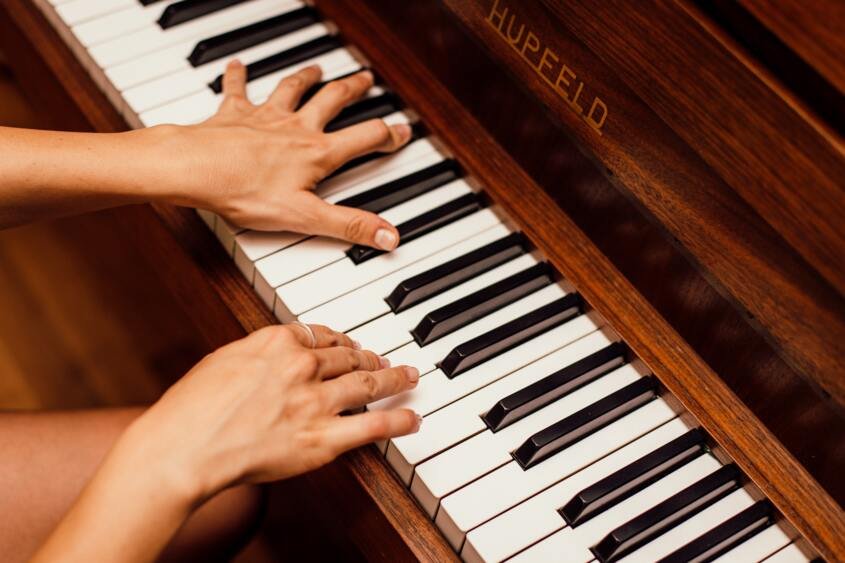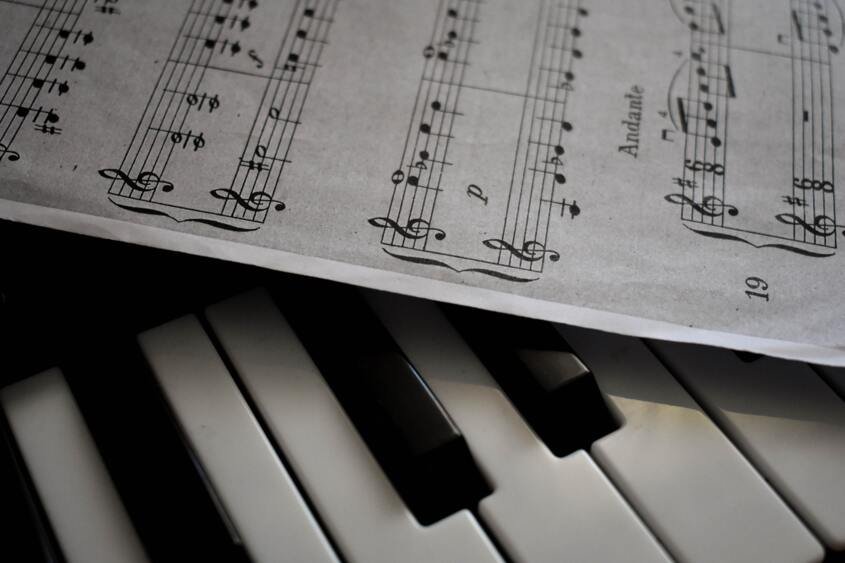A Guide To Remembering Piano Notes
As a piano enthusiast, acquiring the ability to read music is crucial to truly learn the piano. Once you can recognize the notes, you can play anything you want to without much hassle. While remembering piano notes may seem unnerving at first, there are several hacks to easily retain them in your memory.
In this article, we will cover different strategies that will help you remember piano notes efficiently. Without further ado, let’s dive right in!
How To Remember Piano Notes
When you use a combination of approaches to remember piano notes, it becomes easier for you to acquire fluency in reading music. Below, we will be discussing some of the approaches you need to master.
We suggest putting this cheat sheet from Amazon at the beginning steps to focus more on reading chords properly than memorizing them.
For more information Click Here!
All-round Learning
More often than not, there is a gap in reading music due to the lack of supporting skills. The all-round learning concept states that in order to remember piano notes, you need to put all your skills to use to further advance your learning.
When you master these skills, your learning journey gets a broader touch and feels more connected as a whole. Here’s how you can get started.
- Careful Listening
- Active focus on the fingers
- Knowing Your Way Around The Piano
- Having A Sense of Key
Careful Listening
Listening to music carefully is one of the most crucial yet underrated skills for piano enthusiasts. Most learners often neglect this skill while synchronizing finger movements and registering new information.
Once you start playing the piano, actively train your ears to recognize the notes without looking at the keys. This way, you should be able to recognize A from C.
Take the help of a piano teacher so that they can help you perform different note recognition exercises. Moreover, listen to at least 3 different piano pieces every day. Reduce the tempo and just keep listening. Gradually, try to recognize each note while it’s being played. This way, you’ll be able to train your ears to recognize piano notes.
Active Focus On The Fingers

Photo by Juan Pablo Serrano Arenas from Pexels
Sometimes, being aware of your finger movements is all it takes to remember piano notes. Your fingers must automatically position on 1 note per finger. While it sounds pretty simple, it will take quite a while to get the hang of it.
At the start of your learning journey, you’ll notice how your fingers try to cover everything at once. This can be one of the primary reasons for slow progress, especially if you’ve been struggling with reading accuracy.
Do not try to cover anything larger than a five-note span at one go. Take it easy - you can’t become Mozart overnight. Trying to place your fingers everywhere on the piano will only add to your struggles.
Having A Sense of Key
Having a sense of key refers to knowing the rhythmic language of music. Understanding piano scales is the first step in this field.
Mastering this art is extremely important for piano learners because it’s not just about playing the notes quickly - it’s also predicting which note will come up next. For instance, a song in G major is very likely to end with a G.
This prediction skill won’t come to you in a day. Practicing different piano pieces religiously every day does the work. Ask your piano teacher to assign you relevant tasks to heighten your sense of keys.
Knowing Your Way Around The Piano
Knowing your way around the piano is one of the most important skills to remembering piano notes. For instance, if you’ve started with the middle C, you should be aware that you’ll be on F if you move 3 notes upward. The goal here is to work it out without feeling the need to look at your piano throughout the entire time.
Start practicing finger movements when you’re learning scales. Additionally, to make it fun and engaging, randomly stop on a certain scale while playing the piano. Label the note without looking at your piano and then check if you got it right. Reward yourself with a cookie or a favorite ice cream if you get it right.
Using Labels And Mnemonic Devices
Labels and mnemonic devices can benefit you more than you think. Here’s a step-by-step guide to making your learning experience easier.
Step 1 - Label white spaces on your piano for the treble clef
The first step to reading sheet music is to look at the treble clef. A treble clef refers to the musical symbols that indicate the notes represented by spaces and lines of a stave. A clef will signal which notes you have to play using your right hand.
If you’re a beginner, label the keys with letter names of the spaces and lines. Name the white spaces ‘F-A-C-E’ starting at the bottom. Going up to the top line, name the lines ‘E-G-B-D-F’. Simple mnemonic devices will help you remember the names of the spaces and lines. For instance, simply remember the phrase ‘Every Good Baby Deserves Fruitcakes’ for ‘E-G-B-D-F’.
Don’t try to memorize everything at one go. Work a little on the memorization part every day.
Step 2 - Write the names of the note letters

Once you’ve labeled the white spaces, take a piece of music you’re interested to learn. Write the letter names below the music notes of your right hand in the treble clef. Make sure you use a pencil so that you can erase those later.
Note that this isn’t a good practice for the long run, but it’s okay if you’re just starting out. Again, customize the writings as you deem fit. If there’s only one note you’re struggling to remember, simply jot down the name of that one-note letter.
Focus on the white notes for now. You can worry about the black keys, i.e., the sharps and flats, later.
Step 3 - Memorize letter names before moving to bass clef
Once you’ve memorized the spaces and lines for the right hand, practice them a few times to see if you get them right. Next, move on to learning piano notes on the bass clef, where you’ll learn the same things on your left hand.
Step 4 - Label your spaces GBDFA and ACEGB
The bass clef will start at line F. At the bottom of the page, label the spaces as A-C-E-G-B. You can remember this space with the mnemonic ‘All Cats Eat Grape Bowls’.
Afterward, label your line G-B-D-F-A. Remember this one as ‘Great Batsmen Deserve Fruits Always’. Make sure you memorize these notations, too. Take the same piece of music you took in Step-2, and label all the notes in the bass clef.
Step 5: Label Your Fingers
Labeling your fingers is a simple way to remember notations. At first, look for a hand diagram to number your fingers. Your thumb should be marked as ‘1’ and your pinky as ‘5’ for your right hand. Do the same for your left hand.
Start with easier songs to play, such as ‘Jingle Bells, ‘Mary Had A Little Lamb’, ‘Hot Cross Buns’, and ‘Three Blind Mice’. These songs only consist of C-G notes and the numbers 1-5. Begin on the middle C and place both your thumbs on the note. Make sure you align your hands properly so that your left little finger ends on 5 (F) and your right little finger finishes on 5 (G).
Always begin with the white notes. If it’s more help, write the numbers beside the names of the letters. When you read your piece, sing the numbers or letters while playing your piano. After some practice, erase the letters and see if you can still remember the rhythm and pattern from muscle memory.
This way, reading music notes will become second nature and you don’t have to rely on labels forever. Soon enough, you won’t even need to write them down.
Bonus Tip
While being able to read sheet music is a step-up in your journey toward mastering the piano, it won’t be all. You actually need to study the language to fully understand the depth of communication, intention, and connection. These are emotions you won’t find on notations. When you deliver your performance understanding these nuances, the impact will be much more powerful.
That being said, remember there is no right or wrong way to learn sheet music. Take this article as an avenue of options you might use to remember piano notes. If you need the help of a piano tutor, we’re here to help.
From our database of 2700+ teachers, you can find an instructor near your location and suited to your needs. Our teachers are willing to offer both online and in-person lessons. As a student, all you need to do is sign-up with us for FREE. Join us to start your journey toward becoming a piano maestro today!
Has this article helped you learn a couple of tips and tricks to remember piano notes? Which of these tips has helped you the most? Let us know in the comments below!
